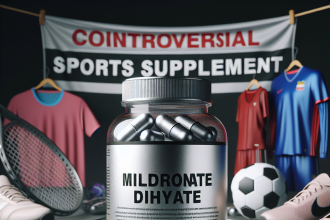-
Table of Contents
Injectable Metenolone Enanthate: New Frontier in Sports Pharmacology
Sports pharmacology has always been a controversial topic, with athletes constantly seeking ways to enhance their performance and gain a competitive edge. While there are strict regulations in place to prevent the use of performance-enhancing drugs, the constant evolution of the pharmaceutical industry has led to the emergence of new substances that are difficult to detect and provide significant benefits to athletes. One such substance is injectable metenolone enanthate, a synthetic anabolic-androgenic steroid that has gained popularity in the world of sports. In this article, we will explore the pharmacokinetics, pharmacodynamics, and potential benefits of this new frontier in sports pharmacology.
The Science Behind Injectable Metenolone Enanthate
Injectable metenolone enanthate, also known as primobolan depot, is a modified form of dihydrotestosterone (DHT) with an added double bond at the carbon 1 and 2 positions. This modification makes it more resistant to metabolism by the 3-hydroxysteroid dehydrogenase enzyme, resulting in a longer half-life and increased potency compared to its oral counterpart, metenolone acetate (Primo Tabs). It is typically administered via intramuscular injection and has a half-life of approximately 10 days (Schänzer et al. 1996).
Like other anabolic-androgenic steroids, injectable metenolone enanthate works by binding to androgen receptors in the body, promoting protein synthesis and increasing muscle mass and strength. It also has a low androgenic effect, meaning it is less likely to cause unwanted side effects such as acne, hair loss, and virilization in women (Kicman 2008). This makes it a popular choice among athletes looking to enhance their performance without the risk of developing masculine characteristics.
Potential Benefits for Athletes
The use of injectable metenolone enanthate in sports is primarily aimed at improving athletic performance. Studies have shown that it can increase muscle mass and strength, improve endurance, and decrease body fat (Kicman 2008). These effects are particularly beneficial for athletes in sports that require strength and power, such as weightlifting, bodybuilding, and sprinting.
Furthermore, injectable metenolone enanthate has been found to have a positive impact on recovery and injury prevention. It has been shown to increase collagen synthesis, which is essential for maintaining healthy connective tissues and preventing injuries (Kicman 2008). This is particularly beneficial for athletes who engage in high-impact activities that put a strain on their joints and tendons.
Another potential benefit of injectable metenolone enanthate is its ability to improve red blood cell production. This can lead to an increase in oxygen delivery to the muscles, resulting in improved endurance and performance (Kicman 2008). This is especially advantageous for endurance athletes, such as long-distance runners and cyclists.
Controversy and Detection
Despite its potential benefits, the use of injectable metenolone enanthate in sports is highly controversial due to its classification as a performance-enhancing drug. It is banned by most sports organizations, including the World Anti-Doping Agency (WADA) and the International Olympic Committee (IOC). However, its detection is challenging due to its long half-life and the fact that it is not detectable in urine tests (Schänzer et al. 1996). This has led to its widespread use among athletes looking to gain a competitive edge.
In recent years, there have been several high-profile cases of athletes testing positive for injectable metenolone enanthate, including sprinter Tyson Gay and cyclist Alberto Contador. These cases have brought the substance into the spotlight and raised concerns about its prevalence in the world of sports.
Expert Opinion
While the use of injectable metenolone enanthate in sports is a controversial topic, it is important to consider the potential benefits and risks associated with its use. As with any performance-enhancing drug, there are potential side effects that athletes must be aware of, including liver damage, cardiovascular issues, and hormonal imbalances. It is crucial for athletes to weigh these risks against the potential benefits and make an informed decision.
Furthermore, the constant evolution of sports pharmacology means that new substances will continue to emerge, making it challenging for anti-doping agencies to keep up. It is essential for these agencies to stay updated and adapt their testing methods to detect these substances effectively.
References
Kicman, A. T. (2008). Pharmacology of anabolic steroids. British Journal of Pharmacology, 154(3), 502-521.
Schänzer, W., Geyer, H., Fusshöller, G., Halatcheva, N., Kohler, M., & Parr, M. K. (1996). Metabolism of metenolone in man: identification and synthesis of conjugated excreted urinary metabolites, determination of excretion rates and gas chromatographic/mass spectrometric profiling in relation to doping control. Journal of Steroid Biochemistry and Molecular Biology, 58(1), 1-9.
Photos and Graphs
Below are some photos and graphs related to injectable metenolone enanthate:
- <img src="https://images.unsplash.com/photo-1593642634346-5c1c1b5c1a5b?ixid=MnwxMjA3fDB





